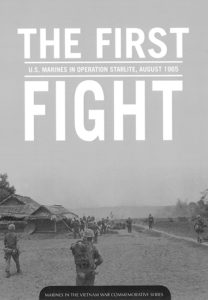 By Rod Andrew Jr., Marine Corps University, History Division, Quantico, VA (2015)
By Rod Andrew Jr., Marine Corps University, History Division, Quantico, VA (2015)
Reviewed by Timothy Heck
Colonel Rod Andrew’s The First Fight is part of a larger official commemorative effort dedicated to the Marine Corps’ involvement in Southeast Asia from the early 1960s until 1975. This pamphlet history by Marine Corps University is a concise and well-told battle history. Covering the battle between Marines of Regimental Landing Team 7 (RLT 7) and the 1st Viet Cong Regiment from 18 to 24 August 1965, The First Fight is a balanced analysis of the Marines’ first major combat operation in Vietnam.
Having landed in Vietnam just months prior, the Marines were initially ordered to not engage in day-to-day combat actions against the Viet Cong. Rather, the Marines were to provide local area security and conduct routine patrolling. As part of General William Westmoreland’s more aggressive (and more conventional) strategy, the Marines found their initial orders replaced by orders to seek out and engage with Viet Cong main force units. With that change, the Marine Corps lost its opportunity to focus on a counter-insurgency strategy through “ink-blot”-type tactics used with success by the British in Malaya. “In many ways, Operation Starlite would represent the coming ascendancy of [Westmoreland’s conventional] approach to fighting the war.”
Operation Starlite was the first regimental-sized battle by American forces in Vietnam. Preceding the better-known Ia Drang battle (made famous by Joseph Galloway and Lt. Gen. Harold G. Moore’s book We Were Soldiers Once….And Young), Operation Starlite also represented the first amphibious landing on a hostile shore in Vietnam, the first large-scale vertical envelopment, and the first fight with main force Viet Cong. Its impact would be felt for the next decade.
The battle itself is told as chronologically as possible given the separate maneuver and fire support elements that each had their fights. While hindsight benefits the historian in writing about what happened, the participants did not have the same clarity. As Colonel Andrew stated in an interview with this reviewer, “the author is trying to impose order on a battle that is in the midst of the fog of war.” He succeeds in The First Fight. The result is a bird’s eye view of the battle that dives into individual actions before returning to the larger operational picture, maintaining both historical clarity and the sense of chaos felt by those present.
One of the strengths of The First Fight is its use of maps. Aided by the tactical operations map used by 2nd Battalion, Fourth Marine Regiment (2/4) during the battle, the recreated maps assist in providing clarity to the chaos of the battle. Given its intended audience of fellow Marines, the maps are perfect compliments to the text, eliminating the need for excessive explanation. Lay readers, however, will need familiarity with standard American operational graphics (see FM 1-02 Operational Terms and Graphics for an explanation and examples of American operational graphics and their meanings).
Academic historians will observe the omission of foot or end notes from the final text. As a pamphlet history intended to be used for the education and training of Marines, the omission is understandable. Colonel Andrew includes an essay on sources at the conclusion, explaining most sources are located in the oral history archives of the Marine Corps History Division, at the National Archives, and at the Alfred M. Gray Marine Corps Research Center. Furthermore, he conducted several interviews with survivors to flesh out the details of the archived reports.
Operation Starlite’s impact on American involvement in Vietnam is apparent in the conduct of the war following the battle. Westmoreland’s idea of force-on-force combat as the key to victory largely supplanted the ideas of counterinsurgency. Colonel Andrew covers the shift in mindsets by both American and North Vietnamese leadership in the ending section entitled “Reactions and Lessons Learned.”
The First Fight presents a balanced summary of the first major American combat operation in Vietnam. Less expensive than Otto Lehrack’s The First Battle: Operation Starlite and the Beginning of the Blood Debt in Vietnam, Colonel Andrew has synthesized and presented the battle and its impact on the American War in Vietnam in an easily digestible pamphlet history that includes excellent maps and engaging insets on the men and equipment of RLT 7.
Download a PDF Copy of This Book
Timothy Heck is a graduate student at Kings’ College, London, in the Department of War Studies. He is an artillery officer by training.


James Lowery
James Lowery
Kenneth Toline
Tony
Matthew Primus